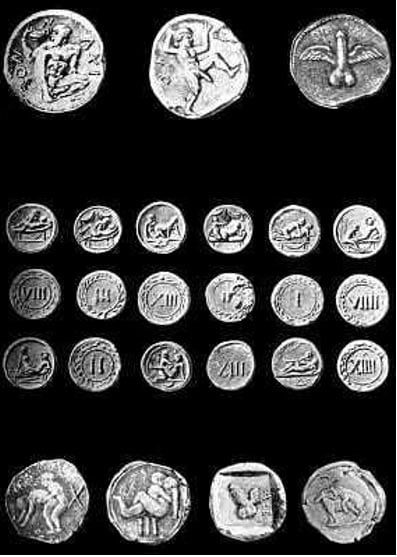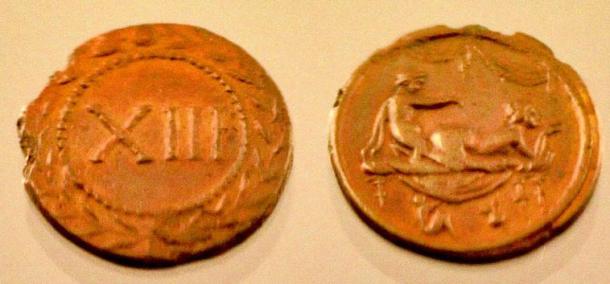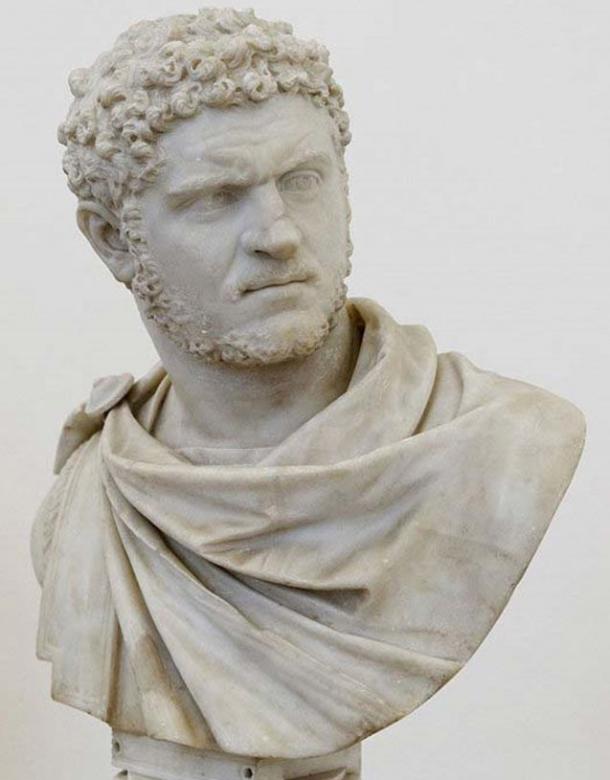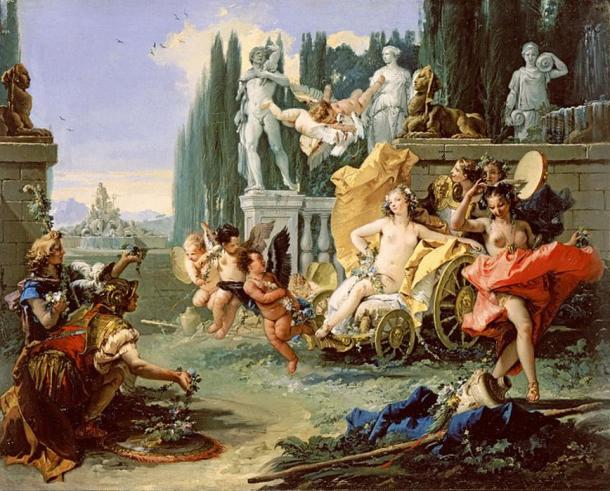
Spintriae, The Roman Sex Coins That Showed What Was on The Menu
There is a curiosity that belongs to ancient Roman history which historians are yet to solve; there exists a collection of Roman brass coins or tokens that depict sexual acts on one side and a numeral on the other. They were not part of the normal moneyed economy and they were used for just a short time in the first century. These so-called Roman sex coins may have been used to obtain entry to brothels, pay prostitutes or even function much like a modern-day menu, where customers who did not speak Latin could handover the token depicting the act they desired. But the truth is, noone really knows.
Today, there is a strong, negative stigma surrounding the occupation of prostitution. It is often looked upon as “sinful”, “detestable”, and “shameful”—both for the prostitute and the participant. In ancient Rome, while everyone certainly had their own views of the practice, it was far more socially acceptable. In fact, brothels were somewhat of a staple in vacation cities like Pompeii and Herculaneum. (Which is helpful for archaeologists, as both those sites remains “frozen” in time.) These staples eventually grew to encourage their own form of coinage, called spintriae in the Medieval period (though this name is misleading in ancient records). The prevalence of prostitution in Roman culture is highlighted through the wide circulation of these coins, and the plethora of imagery in the aforementioned vacation sites in southern Italy.
Ancient Sex Tokens - A Different Kind of Coinage
Roman brothel tokens were rather obvious to the everyday money-handler. The token had various sexual acts depicted on both the front and rear of the coins, usually the participants on the coin in the act of intercourse. Some depicted phalluses instead, full-formed and often with wings attached, likely indicating the virility of the man using the coin. While male prostitutes and female participants were not uncommon, it was far more common—as far as literature can tell—that wealthy males sought the company of a meretrix, or legal female prostitute.
It is also notable that the tokens predominately depict male-female relations rather than relations of the same sex, likely indicating that homosexuality (at least outward homosexuality) had become far less acceptable by the time of the Romans than it was for their predecessors in ancient Greece.

19th century engraving of "Spintriae" (Roman brothel tokens) purportedly found in Pompeii. (Public Domain)
Roman Sex Menu
One of the most prominent theories about the creation and purpose of the coins was to advertise the prices of sexual acts. Further, in passing a coin between two people—i.e., the buyer and the “seller”—one could maintain a level of privacy. This would have been particularly important to those of high status who did not want their late night dalliances known. It is believed by some scholars that “the sex act depicted on each coin corresponds to the price listed on the opposite face,” which has also been considered clever as it is “a system that would also have helped dissolve language barriers”.
If this theory is true, then one must consider that the coins themselves were not forms of payment; rather, they were more akin to calling cards or order slips. As one would say, “I would like a number 4” at McDonald’s and pay for their food at the window, an ancient Roman would pass the token and then subsequently pay for the service before or after it occurred.
- Phryne, The Ancient Greek Prostitute Who Flashed Her Way to Freedom
- Ten Powerful and Fearsome Women of the Ancient World
- The Houses of Pleasure in Ancient Pompeii
A more recent find of a Roman brothel token in London, called the “Putney token” for the bridge it was found near, was examined in 2012. As it is known the Romans had forts, camps, etc. in ancient Britain, the theory that these coins were used to get around language barriers is furthered. Britain’s Romanization was slow, thus so was the spread of the Roman language; however, an image of sexual intercourse is universally understood.

A Roman brothel token. (Mathias Kabel/CC BY SA 3.0)
Were the Tokens an Early Form of Payment?
It is possible that these tokens were at some point used as a form of payment. Despite circulating only in brothels and between buyers and sellers, there is an indication that it would have been in the participants’ best interests if the coins were worth something. According to Geoffrey Fishburn from the Social Sciences Department of the University of NSW in his article ‘Is that a spintria in your pocket, or are you just pleased to see me?’, it would be extraordinary of this were the case because “then we have evidence of a distinct sub-economy within the larger Roman economy, one with its own distinctive market (for sex), and spintriae as a particular type of coin destined for special uses; no other market, so far as I am aware, was so privileged.”
Cassius Dio, a Roman historian in the 3rd century AD, recounts one tale during the reign of Caracalla in which a coin bearing the face of the emperor was used in a brothel. This was seemingly seen as an insult to the emperor, and the man who used the coin was sentenced to death:
“A young knight carried a coin bearing his image into a brothel, and informers reported it; for this the knight was at the time imprisoned to await execution, but later was released, as the emperor died in the meantime.”
-Cassius Dio, 16.5.

Bust of the emperor Caracalla. ( CC BY 2.5 )
Granted, Caracalla has been described as one of the more temperamental emperors of the Roman Empire and perhaps reacted far more angrily than another emperor in this position would have; yet this tale indicates the that it might be best to keep sexual favors and imperial coinage separate from one another.
- Lost in Translation? Understandings and Misunderstandings about the Ancient Practice of “Sacred Prostitution”
- The secret life of an ancient concubine
- Poet Sappho, the Isle of Lesbos, and sex tourism in the ancient world
A Different Perspective
Prostitution was far more of an acceptable “career choice” (it wasn’t necessarily a choice) in ancient Rome than many believe; the current stigma of prostitution has damaged the reputation of what many consider the oldest occupation in history. Roman historians Livy, whose History of Rome is comprehensive, and Tacitus, credited as one of the better surviving sources of Roman culture and war, both dictate that prostitutes often had positive reputations, and often came from good families.
Emperor Augustus encouraged the occupation, making it “neither illegal nor stigmatized in ancient Rome, and in fact it was not unusual for an independent-minded upper-class woman to become a courtesan; when Augustus decided to encourage reproduction in the upper classes by taxing unmarried adult patricians, many women registered as whores so as to avoid being forced to marry.” (McNeill)
Thus, one should be careful about putting one’s own cultural perspectives on the ancient position, as the influx of Roman tokens found only furthers the reality that prostitution was a highly respected field for a long time.

‘The Empire of Flora’ (circa 1743) by Giovanni Battista Tiepolo. (Public Domain) Based on Ovid's account of the Floralia, a festival to the Roman goddess Flora involving prostitutes.
However, at the end of the day, there is still no certainty around how these Roman sex tokens were used. They could have been nothing more than game pieces, tokens for seats at the theatre, or even coins used at the communal baths. At the very least, they show that the Romans were not conservative when it came to their sexual appetites.
Top Image: A Pompeii brothel mural. (Thomas Shahan/CC BY 2.0) Insert: A Roman brothel token.
Updated on August 3, 2021.
References
“Cassius Dio: Roman History.” (trans. Bill Thayer) Leob Classical Library through University of Chicago. Accessed January 29 2018. http://penelope.uchicago.edu/Thayer/E/Roman/Texts/Cassius_Dio/78*.html#16
Fishburn, George. 2007. “Is that a Spintria in your Pocket, or Are You Just Pleased to See Me?” From Regarding the Past: Proceedings of the 20th Conference of the History of Economic Thought. Society of Australia: University of Queensland, 11-13 July 2007. pp. 225-236.
Gonzalez, Robbie. 2013. “Ancient Roman coins depict sundry sexual acts, but what were they for?” io9: We come from the future. Accessed January 30, 2018. https://io9.gizmodo.com/ancient-roman-coins-depict-sundry-sexual-acts-but-what-1277370698
Jones, Jonathan. 2012. “Porn yesterday: Roman brothel tokens and the rise of erotic art.” Accessed January 30, 2018. https://www.theguardian.com/artanddesign/jonathanjonesblog/2012/jan/04/porn-roman-brothel-tokens-erotic-art
McGinn, Thomas A. J. 2004. “The Economy of Prostitution in the Roman World.” University of Michigan Press. Accessed January 30, 2018. https://muse.jhu.edu/book/12751
McNeil, Maggie. 2012. “The many types of prostitutes in ancient Rome.” The Feministe. Accessed February 1, 2018. http://www.feministe.us/blog/archives/2012/02/20/the-many-types-of-prostitutes-in-ancient-rome/
Weisner, Lauren. 2014. “The Social Effect the Law had on Prostitutes in Ancient Rome.” Grand Valley Journal of History: 3.2, Article 4. Accessed January 30, 2018. http://scholarworks.gvsu.edu/cgi/viewcontent.cgi?article=1120&context=gvjh
















Comments
Hi All,
I guess all i can say is that Rome wasn't prude's about Sex or it wouldn't of been on their coins.
Hi All,
I guess all i can say is that Rome wasn't prude's about Sex or it wouldn't of been on their coins.
ELISABETH DE BOER:
So what you’re saying is that nothing has changed.
More info:
How and why the bones of nearly 100 infants were deposited in a late Roman-early Byzantine sewer beneath a bathhouse at Ashkelon, on the southern coast of Israel, continue to baffle scholars. An initial examination of the remains by Patricia Smith and Gila Kahila of the Hebrew University revealed that most of the bones, discovered in 1988, were intact and that all parts of the skeletons were represented, suggesting that the infants had probably been thrown into the drain soon after death. All of the bones and teeth (unerupted) are comparable to those of newborn infants. The absence of neonatal lines--prominent marks in the enamel of deciduous teeth and first permanent molars, which are considered evidence of survival for more than three days--indicates the babies died shortly after birth.
The number of infants, all of the same age and with no signs of disease or skeletal malformation, suggested infanticide rather than a catastrophe such as epidemic, war, or famine, in which a range of ages might be expected. Smith and Kahila thought the Ashkelon infants were probably girls because female infanticide was widespread in Roman society. In a letter written in 1 B.C a husband instructs his pregnant wife, "if it is a boy keep it, if a girl discard it," and the Roman poet Juvenal mentions children "abandoned beside cesspools."
Ariella Oppenheim of the Hebrew University and her colleagues have now analyzed DNA from the bones to determine the sex of the infants, for which standard osteological methods are unreliable. They extracted DNA from 43 left femurs, using a single bone to eliminate the possibility of analyzing the same infant's DNA more than once. The extraction was successful in 19 cases, 14 of which were male and five female. They checked their results by making multiple DNA extractions and analyses for each bone, obtaining the same results in 17 of the specimens. The significant number of male victims was unexpected, they say, and raised the intriguing possibility that these infants may have been the unwanted offspring of courtesans working in the bathhouse.
There are problems with this interpretation. If prostitutes were discarding all infants, a ratio closer to 1:1 of males to females would be more likely (about 20 males are born for every 21 females). Either the results of the analysis are somehow biased or some selectivity took place in the abandonment of the infants. Harvard archaeologist Larry Stager, director of the Leon Levy Expedition to Ashkelon, interprets this as evidence that male infants may have been discarded while females were brought up to work in the brothel.
The link between the contents of the sewer and the bath, built over several houses, is not entirely clear. According to Stager the bath and sewer are both fourth-century constructions. The remains of the babies were found in a gutter in the bottom of the sewer, which filled with debris and went out of use by ca. 500, suggesting the babies may be contemporary with the functioning of the bath. In a 1991 report Stager noted that hundreds of fragments of ceramic oil lamps, some decorated with erotic motifs and others with mythological scenes, were found in a small street-front room of one of the houses. Although the lamps appeared unused, Stager claimed they were "solely for the amusement of the owner" and were not being sold from the house. The possibility that the bath also served as a brothel was considered but dismissed in the same article. But in the DNA report, published in Nature, the lamps are associated with the bath, not the earlier houses, and considered to be evidence that it was also a brothel.
Based on ancient sources, historian John M. Riddle of North Carolina State University raises additional questions about the new interpretation. "The literary evidence--classical, medieval, and early modern--is virtually united in claiming that prostitutes knew what to do to prevent full-term pregnancies," he notes. "Why would prostitutes at Ashkelon be different?" A variety of contraceptive methods and abortifacients was used in the classical world (see ARCHAEOLOGY, March/April 1994). Among the church fathers, Jerome (348-420) condemned the use of potions that cause "sterility and murder those not yet conceived," while Augustine of Hippo (354-430) held that as long as the fetus was no more than "some sort of living, shapeless thing" homicide laws did not apply because it had no senses and no soul. Riddle also says that after the first century A.D. the value of slaves increased to the point that unwanted babies could be and were sold to dealers. Neither of the proposed explanations--female infanticide or discarding of unwanted children by prostitutes--seems to match the evidence.
I wonder about this part:
"The literary evidence--classical, medieval, and early modern--is virtually united in claiming that prostitutes knew what to do to prevent full-term pregnancies," he notes. "Why would prostitutes at Ashkelon be different?"
What were these methods the literary 'evidence' mentions then? My great grandmother would have loved to know.
Prostitutes in ancient Rome were almost all slaves. The demand for prostitution is always larger than the (voluntary) supply. In modern times there is women trafficking to meet demand, but ancient Rome was a slave holding society, so slaves did the job. Archeologists recognize Roman brothels, not (as you may imagine) by titillating fresco's a la the Pompeii excavations, but by the pits with baby carcasses next to them. All male carcasses, as the girls were allowed to live, to serve the next generation of Johns. “Career choice”? Really?
"The current stigma of prostitution has damaged the reputation of what many consider the oldest occupation in history."
Something more demeaning can hardly be said of women, who were earning their own food as hunter gatherers first, and later became the world's main food suppliers as farmers. (In traditional societies, the vast majority of food is still produced by women: 90% in Africa, 60% in Asia.) Please girl, inform yourself better.
Pages